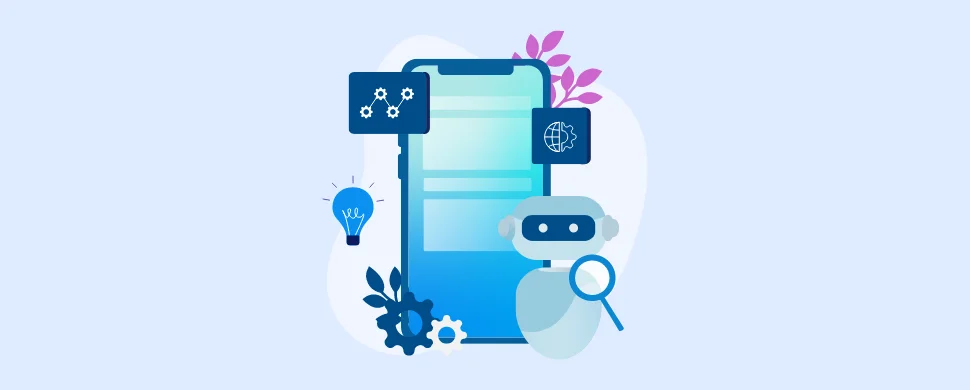
Himanshi Arora
5 min read
In today's fast-paced business environment, staying ahead of the competition and providing exceptional customer experiences is paramount. As companies strive to meet the demands of an increasingly digital world, the development of chatbot has emerged as a revolutionary technology that is shaping the growth story of companies across industries.
By understanding the power and potential of chatbot development, companies can take advantage of its opportunities to become more efficient, improve customer satisfaction and ultimately shape their growth story in an increasingly digital age.
What are Chatbots?
A chatbot , powered by artificial intelligence and natural language processing, is a software program designed to engage in human-like conversations with users. By understanding user questions and providing relevant answers, chatbots have become invaluable tools for businesses looking to improve customer interactions, automate processes and accelerate growth.
Chatbots have a wide range of applications, from customer support and lead generation to personalized recommendations and process automation. By integrating chatbots into platforms like websites, messaging apps, and voice assistants, businesses can provide real-time support, handle questions, and chat with customers.
Industries Taking Benefits of Chatbot App Development

Various industries have utilized chatbot application development to improve their operations and customer experience. Some of these industries include:
-
Customer Service
Chatbots have revolutionized customer service by providing instant support, answering questions and solving problems efficiently.
-
E-commerce and retail
Chatbots help customers make product recommendations, track orders, and provide a personalized shopping experience that increases sales and customer satisfaction.
-
Banking and Finance
Chatbots provide 24/7 support, provide account information, assist with transactions and improve security by verifying user identities.
-
Travel and Hospitality
Chatbots help travelers book, offer destination recommendations, provide real-time assistance and handle customer inquiries.
-
Healthcare
Chatbots enable virtual consultations, offer symptom checks, medication reminders and improve access to healthcare.
-
HR
Chatbots simplify HR processes by answering questions about employees, automating input procedures and assisting with performance evaluation.
-
Education
Chatbots improve the learning experience by providing personalized assistance, delivering learning materials and automating administrative tasks.
-
Real Estate
Chatbots contact potential buyers, provide property information, assist with property searches, and plan real estate transactions.
These industries have successfully integrated chatbot software to streamline operations, improve customer engagement and drive business growth. Chatbots have become a valuable asset in the digital transformation journey of companies across industries.
How to Develop a Chatbot Application?

Developing a chatbot application involves a systematic process that combines various technical and design aspects. Here are the main steps to developing a chatbot-
-
Define Purpose and Scope
Clearly define the purpose of your chatbot program. Determine if it is used for customer support, lead generation, information service or any other specific function. It guides the development process.
-
Choose a chatbot development platform
Choose a suitable chatbot development platform or framework that meets the requirements of your project. Popular platforms include Dialogflow, IBM Watson, Microsoft Bot Framework and many others. These platforms provide tools, APIs and ready-made components to simplify the development process.
-
Designing conversation flows
Create a conversation flow diagram that describes possible user interactions, intentions, and responses. This helps define the logical flow of conversations and ensures that the chat can efficiently handle input from different users. Consider the different scenarios and potential user questions that a chat room needs to address.
-
Train your chatbot
Use machine learning algorithms and natural language processing (NLP) techniques to train your chatbot with sample conversations and data. This helps the chat engine understand user intent, respond appropriately, and improve its performance over time. Keep improving and updating the training data to improve the accuracy of the chat.
-
Develop integration with external systems
If your chatbot requires access to external systems, databases or APIs, develop the necessary integration. This allows the chat to seamlessly retrieve relevant information, process transactions or interact with other business systems.
-
Enable Natural Language Processing (NLP)
Include NLP capabilities so that the chat can accurately understand and interpret user input. NLP algorithms process a user's text or speech, extract intent, entities, and context, and transform them into a structured form that a chatbot can work with.
-
Test and iterate
Thoroughly test your chatbot to make sure it works as expected and provides a smooth user experience. Perform functional testing, regression testing, and user acceptance testing to identify and fix problems or bugs. Continually iterate and improve chatbot responses, understanding and performance based on user feedback.
-
Development and Monitoring
Once the chatbot development is complete, deploy the chatbot application to the desired platform or channel, such as websites, messaging apps or voice assistants. Monitor user interactions and feedback for further enhancements and improvements.
Remember that chatbot app development is an iterative process. This requires constant monitoring, testing and fine-tuning to ensure optimal performance and user satisfaction. By following these steps and harnessing the power of AI, NLP and conversational design, you can develop a chatbot application that adds value, improves customer experience and drives business growth.
Rise of Chatbot Development

The rise of chatbot development has been significant in recent years, changing the way businesses interact with customers and simplifying operations. Chatbots have gained popularity due to their ability to provide instant and personalized assistance, automate tasks and improve customer experience. Thanks to advances in artificial intelligence and natural language processing, chatbots can understand user questions and respond more accurately, making them even more reliable and effective.
As technology advances, chatbots become increasingly intelligent and capable of handling complex interactions. They are integrated with advanced analytics and machine learning algorithms to provide personalized recommendations, automate transactions and gather valuable customer insights. The increase in the development of chatbots has opened up new opportunities for companies to offer efficient services, increase customer satisfaction and achieve a competitive advantage in the digital environment.
All in all, the rise of chatbot development means a change in the way companies interact with customers and automate processes. Chatbots have become invaluable tools for improving customer experience, making operations more efficient and driving business growth in today's era.

Conclusion
Chatbot development is revolutionizing companies in various industries, providing even better customer experiences and accelerating growth . Companies can develop effective chatbot programs by defining the goal, choosing the right platform, designing chat flows and integrating with external systems. Continuous monitoring, testing and iteration are critical to optimizing performance.
At WhitenApps Solutions , we understand the possibilities of chatbot development and can help companies open up new opportunities. Use chatbots to stay ahead in the digital age and transform your business today.

